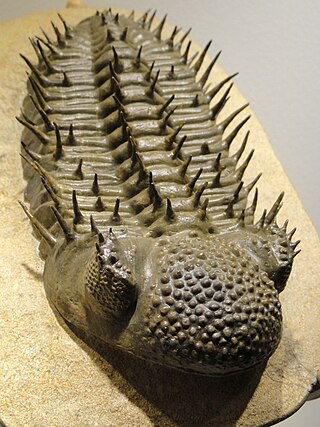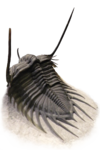
The Devonian is a geologic period and system of the Paleozoic era during the Phanerozoic eon, spanning 60.3 million years from the end of the preceding Silurian period at 419.2 million years ago (Ma), to the beginning of the succeeding Carboniferous period at 358.9 Ma. It is named after Devon, South West England, where rocks from this period were first studied.

Trilobites are extinct marine arthropods that form the class Trilobita. Trilobites form one of the earliest known groups of arthropods. The first appearance of trilobites in the fossil record defines the base of the Atdabanian stage of the Early Cambrian period and they flourished throughout the lower Paleozoic before slipping into a long decline, when, during the Devonian, all trilobite orders except the Proetida died out. The last trilobites disappeared in the mass extinction at the end of the Permian about 251.9 million years ago. Trilobites were among the most successful of all early animals, existing in oceans for almost 270 million years, with over 22,000 species having been described.

Phacopida ("lens-face") is an order of trilobites that lived from the Late Cambrian to the Late Devonian. It is made up of a morphologically diverse assemblage of taxa in three related suborders.

The Phacopina comprise a suborder of the trilobite order Phacopida. Species belonging to the Phacopina lived from the Lower Ordovician (Tremadocian) through the end of the Upper Devonian (Famennian). The one unique feature that distinguishes Phacopina from all other trilobites are the very large, separately set lenses without a common cornea of the compound eye.

Phacopidae is a family of phacopid trilobites that ranges from the Lower Ordovician to the Upper Devonian, with representatives in all paleocontinents.

Phacops is a genus of trilobites in the order Phacopida, family Phacopidae, that lived in Europe, northwestern Africa, North and South America and China from the Late Ordovician until the very end of the Devonian, with a broader time range described from the Late Ordovician. It was a rounded animal, with a globose head and large eyes, and probably fed on detritus. Phacops is often found rolled up ("volvation"), a biological defense mechanism that is widespread among smaller trilobites but further perfected in this genus.

Greenops is a mid-sized Devonian trilobite of the order Phacopida, subfamily Asteropyginae. They are mainly reported from the mid-Devonian Hamilton Group of upstate New York and southwestern Ontario. A similar-looking trilobite from Morocco is often mis-labelled Greenops. Greenops had schizocroidal eyes, large genal spines and short, sharp spines at the tip of each segment of the pygidium ("tail"). Greenops lived in warm, fairly deep water. In the Hamilton Group of New York, they are found with Eldredgeops, Dipleura and Bellacartwrightia, a trilobite that resembles Greenops but has much larger pygidial spines. In Ontario, they are found in the Widder Formation, which outcrops at Arkona, where they are, by far, the dominant trilobite.

Chotecops is a genus of trilobites from the order Phacopida, suborder Phacopina, family Phacopidae. It was initially erected as a subgenus of Phacops but some later authors thought it distinctive enough to raise its status. Species assigned to this genus occur between the Emsian and the Famennian. Chotecops is the most abundant trilobite in the Hunsrück Slate and due to the excellent preservation, often soft tissue such as antennae and legs have been preserved as a thin sheet of pyrite.

Eldredgeops is a genus of trilobites in the order Phacopida, family Phacopidae, known from the late Middle and earliest Upper Devonian of Morocco and the USA.

Drotops is a genus of trilobites from the order Phacopida, family Phacopidae that lived during the Eifelian of the Middle Devonian. It was described by Struve in 1990 under type species Drotops megalomanicus. Their fossils are found in present-day Morocco, specifically the Maïder Region located South West of Erfoud.
The Devonian Mahantango Formation is a mapped bedrock unit in Pennsylvania, West Virginia, and Maryland. It is named for the North branch of the Mahantango Creek in Perry and Juniata counties in Pennsylvania. It is a member of the Hamilton Group, along with the underlying the Marcellus Formation Shale. South of Tuscarora Mountain in south central Pennsylvania, the lower members of this unit were also mapped as the Montebello Formation. Details of the type section and of stratigraphic nomenclature for this unit as used by the U.S. Geological Survey are available on-line at the National Geologic Map Database.

Erbenochile is a genus of spinose phacopid trilobite, of the family Acastidae, found in Lower to Middle Devonian age rocks from Algeria and Morocco. Originally described from an isolated pygidium, the first complete articulated specimen of E. erbeni revealed the presence of extraordinarily tall eyes:
"Straight-sided towers of lenses... with [up to] 18 lenses in a vertical file"

The Columbus Limestone is a mapped bedrock unit consisting primarily of fossiliferous limestone. It occurs in Ohio, Pennsylvania, and Virginia in the United States, and in Ontario, Canada.

The Devonian Jeffersonville Limestone is a mapped bedrock unit in Indiana and Kentucky. It is highly fossiliferous. The Vernon Fork Member contains Volcanic ash associated with the Tioga Bentonites.
Fossils of many types of water-dwelling animals from the Devonian period are found in deposits in the U.S. state of Michigan. Among the more commonly occurring specimens are bryozoans, corals, crinoids, and brachiopods. Also found, but not so commonly, are armored fish called placoderms, snails, sharks, stromatolites, trilobites and blastoids.

Paleontology in Ohio refers to paleontological research occurring within or conducted by people from the U.S. state of Ohio. Ohio is well known for having a great quantity and diversity of fossils preserved in its rocks. The state's fossil record begins early in the Paleozoic era, during the Cambrian period. Ohio was generally covered by seawater from that time on through the rest of the early Paleozoic. Local invertebrates included brachiopods, cephalopods, coral, graptolites, and trilobites. Vertebrates included bony fishes and sharks. The first land plants in the state grew during the Devonian. During the Carboniferous, Ohio became a more terrestrial environment with an increased diversity of plants that formed expansive swampy deltas. Amphibians and reptiles began to inhabit the state at this time, and remained present into the ensuing Permian. A gap in the local rock record spans from this point until the start of the Pleistocene. During the Ice Age, Ohio was home to giant beavers, humans, mammoths, and mastodons. Paleo-Indians collected fossils that were later incorporated into their mounds. Ohio has been the birthplace of many world famous paleontologists, like Charles Schuchert. Many significant fossils curated by museums in Europe and the United States were found in Ohio. Major local fossil discoveries include the 1965 discovery of more than 50,000 Devonian fish fossils in Cuyahoga County. The Ordovician trilobite Isotelus maximus is the Ohio state invertebrate fossil.

Paleontology in Illinois refers to paleontological research occurring within or conducted by people from the U.S. state of Illinois. Scientists have found that Illinois was covered by a sea during the Paleozoic Era. Over time this sea was inhabited by animals including brachiopods, clams, corals, crinoids, sea snails, sponges, and trilobites.

Paleontology in Pennsylvania refers to paleontological research occurring within or conducted by people from the U.S. state of Pennsylvania. The geologic column of Pennsylvania spans from the Precambrian to Quaternary. During the early part of the Paleozoic, Pennsylvania was submerged by a warm, shallow sea. This sea would come to be inhabited by creatures like brachiopods, bryozoans, crinoids, graptolites, and trilobites. The armored fish Palaeaspis appeared during the Silurian. By the Devonian the state was home to other kinds of fishes. On land, some of the world's oldest tetrapods left behind footprints that would later fossilize. Some of Pennsylvania's most important fossil finds were made in the state's Devonian rocks. Carboniferous Pennsylvania was a swampy environment covered by a wide variety of plants. The latter half of the period was called the Pennsylvanian in honor of the state's rich contemporary rock record. By the end of the Paleozoic the state was no longer so swampy. During the Mesozoic the state was home to dinosaurs and other kinds of reptiles, who left behind fossil footprints. Little is known about the early to mid Cenozoic of Pennsylvania, but during the Ice Age it seemed to have a tundra-like environment. Local Delaware people used to smoke mixtures of fossil bones and tobacco for good luck and to have wishes granted. By the late 1800s Pennsylvania was the site of formal scientific investigation of fossils. Around this time Hadrosaurus foulkii of neighboring New Jersey became the first mounted dinosaur skeleton exhibit at the Academy of Natural Sciences in Philadelphia. The Devonian trilobite Phacops rana is the Pennsylvania state fossil.

Paleontology in Wisconsin refers to paleontological research occurring within or conducted by people from the U.S. state of Wisconsin. The state has fossils from the Precambrian, much of the Paleozoic, some a parts of the Mesozoic and the later part of the Cenozoic. Most of the Paleozoic rocks are marine in origin. Because of the thick blanket of Pleistocene glacial sediment that covers the rock strata in most of the state, Wisconsin’s fossil record is relatively sparse. In spite of this, certain Wisconsin paleontological occurrences provide exceptional insights concerning the history and diversity of life on Earth.

The Windom shale or Windom member is a member of the Moscow formation in New York. It preserves fossils going back to the Givetian stage of the middle Devonian. The Windom shale is widely known for its high quality trilobite fossils.






















